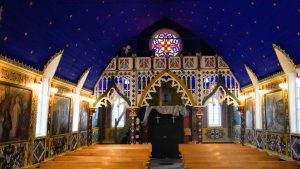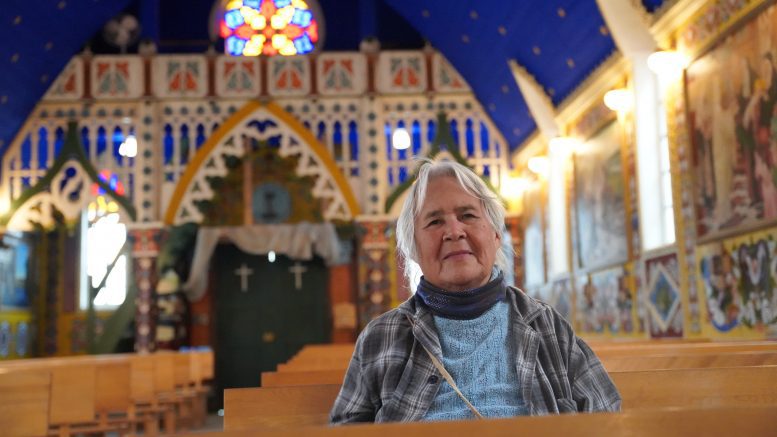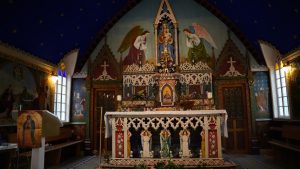The famous Church of Our Lady of Good Hope overlooks the Deh Cho (Mackenzie River) from a bluff in Fort Good Hope.
The church is a small building with a deep history connected to the Sahtu Dene, although they are rarely credited with its creation.
The nearly 150-year-old church — one of the oldest in Canada — is among the most beautiful buildings in the territory.

The Church of Our Lady of Good Hope is recognized as a national historic site of Canada. (Photo by Luke Carroll/ CKLB.)
Vibrant blue ceilings and walls greet viewers as they enter the church, all materials are local and were gathered by the Indigenous people of Fort Good Hope.
This included berries, fish oils and trees from the nearby islands.
Lucy Jackson is a resident of Fort Good Hope who has studied the history of the community’s church.
“A lot of Indigenous people helped to gather up all these materials from on-the-land, and they did a lot of help with the church at that time,” she said. “A lot of the wood material is all local.”
But little credit is given to the key — if not paramount — contribution by the Indigenous people.
“You don’t hear about it,” Jackson said.
Jackson says not only did the community help gather materials, but they also showed Petitot how to use fish oils and made their own paints.
The site is a popular tourist attraction spot and was named a national historic site in 1978.
The completion of the church is nearly unanimously credited to Father Émile-Fortuné Petitot, a Catholic missionary who lived in Fort Good Hope. Petitot was a pedophile and abuser who was temporarily excommunicated.
The Prince of Wales Heritage Centre writes “the building is further distinguished by its association with Father Émile Petitot, renowned ethnologist, linguist and geographer of the Canadian northwest, who lived at the mission from 1864 until 1878 and was responsible for the design and the partial execution of the building’s interior decoration.”
The NWT’s tourism not-for-profit, Spectacular NWT, uses the museum’s bio and no mention is made of the contribution by the community members.
“The history here in the north is pretty skimpy,” said Frank T’seleie, an Elder and leader in Fort Good Hope.
He says this is an ongoing theme. Another example is the Indigenous contribution to the Canol Heritage Trail during World War Two.
“If you look at the colonization of this part of Canada, the contribution that our people made through the development of Canada has never really been documented and continues to be like that,” he said.
T’seleie says he hopes future scholars will research the subject more and give credit to the Indigenous.
The symbol of a church is a controversial subject as the Catholic Church’s involvement with the Residential Schools and the genocide of Indigenous peoples was brought, once again, to the forefront with the discovery of unmarked graves across the country.
T’seleie talked about the church’s role in Residential Schools and particularly discussed the impact it had on his mother.
“She had stayed there for 10 years straight and came back as a teenager. By that time, she forgot her parents,” he said. “She made sure that none of my four siblings never lost our language, we were rooted in our language, I’m forever grateful for that, I still consider it my first language.”
Since May, thousands of unmarked graves of Indigenous children have been found. The Catholic Bishops of Canada have issued an apology, but the Pope is yet to do so.
Jackson says this has been particularly noticeable in younger people.
“With the younger generations, with all the Residential School… We don’t really see them in church,” she said, “but then they should be aware of how their parents before them and their grandparents before them helped to build the church with their own tools.”
Correction: This article previously stated Father Émile-Fortuné Petitot was excommunicated when in fact he was only temporarily excommunicated. CKLB regrets the error.






